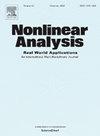Mathematical analysis of steady non-isothermal flows of a micropolar fluid
IF 1.8
3区 数学
Q1 MATHEMATICS, APPLIED
引用次数: 0
Abstract
This paper deals with a boundary value problem (BVP) describing the 3D steady non-isothermal flow of a micropolar fluid (with couple stresses) in a bounded vessel. The presence of couple shear stresses is a consequence of taking into account the rotational degrees of freedom for an elementary volume of a fluid. Since the governing equations of the couple stress fluid are of order 4, for a well-posed setting of a BVP modeling internal flows, it is not enough to prescribe the no-slip (stick) condition on solid walls on a vessel. Therefore, we come across the non-trivial issue of specifying extra boundary conditions for the velocity field that are reasonable from both physical and mathematical points of view. As one of approaches to solving this problem, we suggest introducing a vorticity-type boundary condition with a parameter, the choice of which determines one of two scenarios: either the no-slip regime together with the vanishing of the vorticity on the boundary (the “super-stick” regime) or the no-slip regime under the vanishing of the couple stresses on the boundary. The interpretation of both boundary conditions is proposed in the terms of the normal and tangential components of the couple stress vector. Another important feature of our work is that we take into account the viscous dissipation effect in the energy balance equation unlike conventional approaches that overlook this effect. We introduce both weak and strong formulations of the considered BVP and study the relationship between the ones. Applying a generalized version of the Leray–Schauder fixed-point theorem, we prove the existence of a weak solution and, under additional assumptions for the model data, the uniqueness of this solution. Moreover, some qualitative and quantitative properties of solutions are established. In particular, we analyze the convergence of the constructed solutions to the solutions of the stationary Navier–Stokes system as the couple stress viscosity coefficient tends to zero.
微极流体稳定非等温流动的数学分析
本文研究了微极流体在有界容器内三维非等温稳定流动的边值问题。偶剪应力的存在是考虑到流体的基本体积的旋转自由度的结果。由于耦合应力流体的控制方程为4阶,因此对于一个良好定态的BVP模拟内部流动的设置,规定容器固体壁面上的无滑(粘)条件是不够的。因此,我们遇到了一个重要的问题,即为速度场指定额外的边界条件,从物理和数学的角度来看都是合理的。作为解决这一问题的方法之一,我们建议引入一个带参数的涡度型边界条件,该参数的选择决定了两种情况中的一种:边界涡度消失的无滑移状态(“超级棒”状态)或边界偶应力消失的无滑移状态。这两个边界条件的解释是提出的条款的法向和切向分量的一对应力矢量。我们工作的另一个重要特点是,我们考虑了能量平衡方程中的粘性耗散效应,而不像传统方法那样忽略了这一效应。我们引入了所考虑的BVP的弱和强公式,并研究了它们之间的关系。应用广义的Leray-Schauder不动点定理,证明了一个弱解的存在性,并在模型数据的附加假设下,证明了该解的唯一性。此外,还建立了解的一些定性和定量性质。特别地,我们分析了稳态Navier-Stokes系统在耦合应力黏度系数趋于零时所构造的解的收敛性。
本文章由计算机程序翻译,如有差异,请以英文原文为准。
求助全文
约1分钟内获得全文
求助全文
来源期刊
CiteScore
3.80
自引率
5.00%
发文量
176
审稿时长
59 days
期刊介绍:
Nonlinear Analysis: Real World Applications welcomes all research articles of the highest quality with special emphasis on applying techniques of nonlinear analysis to model and to treat nonlinear phenomena with which nature confronts us. Coverage of applications includes any branch of science and technology such as solid and fluid mechanics, material science, mathematical biology and chemistry, control theory, and inverse problems.
The aim of Nonlinear Analysis: Real World Applications is to publish articles which are predominantly devoted to employing methods and techniques from analysis, including partial differential equations, functional analysis, dynamical systems and evolution equations, calculus of variations, and bifurcations theory.

 求助内容:
求助内容: 应助结果提醒方式:
应助结果提醒方式:


